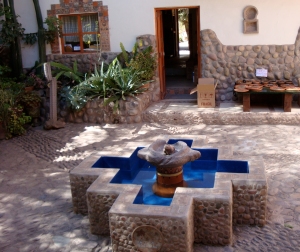 “Imperios” by Fredy Roa, Museo de Arte Contemporario, Cuzco
“Imperios” by Fredy Roa, Museo de Arte Contemporario, Cuzco
If the three animal symbols represent the three worlds, the Chakana or Incan Cross symbolizes the dynamic between the universe and the life it contains. A complex symbol, people have different perspectives on the stories the cross tells, and I will do my best to recount the ones I learned.
The Chakana is a sort of multifaceted map. Astrologically, The three-tiered cross represents the star constellation known as the Southern Cross (http://en.wikipedia.org/wiki/Crux). The twelve corners point to the twelve months of the calendar year. The four prongs represent the directions on earth (the Inca did not refer to the cardinal directions we are accustomed to them).
 Tesoros Del Inca, by Wilber Roa C., Museo de Arte Contemporary, Cusco.
Tesoros Del Inca, by Wilber Roa C., Museo de Arte Contemporary, Cusco.
More importantly however, the Chakana represents the animal worlds of the Condor (Hanan Pacha), Jaguar or Puma (Kay Pacha), and Serpent. When you draw a horizon in the center, the upper half is the spirit world of the Condor (also of the sun and planets), the centerline is feline; the surface of earth and the present world, and the lower half of the cross is the serpent world of the dead.
The circle, however, is an important part of the tale. It speaks to the Andean concept of Ayu, or life community. The circular Ayu illustrates that all living things are connected in an ensemble with no end point. Furthermore, it expresses the reincarnation souls are believed to experience in this tradition. Just as earth’s organisms continually die and birth, a soul is believed to circularly live, die and be reborn. To represent this concept, the circle passes through the three worlds. As you trace the circle you trace the soul’s path – moving from the present world of the living, to the upper world of the spirits, and then into the land of the dead where it will regenerate for the next life. The upper and lower worlds have nothing to do with the Western concept of heaven or hell; all worlds are viewed positively.The hole also denotes Cusco, which is considered the center of the Incan Empire.
 Fountain at Seminario Pottery Guild, Urubamba
Fountain at Seminario Pottery Guild, Urubamba
Chakana is the paramount symbol of the Andean culture, to be seen on almost anyone or anything. The architecture of buildings, temples, and religious santuaries scattered throughout the Andes incorporates this symbol. One example is Sacsayhuamán, the Incan Temple of the Sun located in Cusco. As you arrive, an entrance shaped as the upper half of the Chakana greets you. Many Peruvians and others wear jewelry of the Incan Cross as a charm for protection, for they consider it a means to ward off evil energy (right). In this way the symbol has transcended to a design tool, critical to shaping the energetic result of the physical objects that portray it.






